You must have seen a sparkly, rainbow-like sheen pasted on certain labels and stickers. When the stickers are highlighted the material flashes all colors of the rainbow. However, you are wondering what is a hologram sticker. Fret not, we are going to cover all the important topics related to holographic stickers.
Let’s begin with addressing the basics of the stickers and their major applications.

What is a Hologram Sticker?
What is a hologram sticker? Simply put, a hologram sticker is a two-dimensional surface that houses a three-dimensional image. Unlike traditional stickers, hologram stickers use light diffraction to create a stunning visual effect that pops out of the surface. This illusionary depth is what makes these stickers, so intriguing and versatile.
These captivating labels are not just for aesthetic appeal; they serve several practical purposes across different industries.
Now that we have a basic understanding, let’s explore the myriad uses of hologram stickers.
Uses of Hologram Stickers

1. Brand Authentication:
One of the primary hologram sticker uses is brand authentication. By incorporating holographic elements into their labels, companies can safeguard their products against counterfeiting. The intricate patterns and optical features make it incredibly challenging for counterfeiters to replicate, ensuring the product’s authenticity.
2. Security and Anti-Tampering:
Hologram stickers are equipped with features that make them tamper-evident. Any attempt to remove or alter the sticker leaves a visible mark, serving as a clear indication of tampering. This makes them invaluable for securing sensitive documents, ID cards, and high-value products.
3. Enhanced Product Packaging:
Beyond security, hologram stickers add a touch of glamour to product packaging. Many consumer goods incorporate holographic labels to enhance visual appeal and create a premium, sophisticated image. From cosmetics to electronics, the dazzling effect of hologram stickers elevates the overall packaging aesthetics.
Now that we’ve explored their uses, let’s uncover the benefits that make hologram stickers indispensable in various fields.
Benefits of Hologram Stickers
Visual Appeal:
The most obvious benefit of hologram stickers is their visual appeal. The dynamic, eye-catching designs captivate consumers, making products stand out on crowded shelves. This allure is not just cosmetic—it also contributes to increased brand recognition and consumer trust.
Customization and Versatility:
Hologram stickers offer a high degree of customization. Manufacturers can tailor holographic designs to align with brand aesthetics or convey specific messages. This versatility allows businesses to use hologram stickers across diverse product lines.
Cost-Effective Security Measures:
Implementing hologram stickers as security features is a cost-effective solution for businesses. The initial investment in holographic technology can save substantial amounts in the long run by protecting against counterfeiting and fraud.
Applications Across Industries
Hologram stickers have transcended their initial use as decorative elements and security features. Today, they find applications in a wide range of industries, each harnessing the unique properties of holographic technology.
1. Pharmaceuticals:
In the pharmaceutical industry, hologram stickers play a crucial role in ensuring the authenticity of medications. Counterfeit drugs pose a significant threat to public health, and holographic labels are a formidable defense against this menace.
2. Government Documents and IDs:
Government-issued documents and IDs often feature hologram stickers to prevent forgery. The tamper-evident nature of holographic labels adds an extra layer of security to passports, driver’s licenses, and other identification documents.
3. Event Tickets and Passes:
Sporting events, concerts, and other large gatherings utilize hologram stickers on tickets and passes to prevent unauthorized duplication. The holographic features not only deter counterfeiters but also add an element of exclusivity to the event experience.
Steps to Create Hologram Stickers

You know what is a hologram sticker but creating them requires patience, dedication, and skill. It is a process that combines artistry and technology. Follow this step-by-step guide to embark on the journey of crafting your own mesmerizing holographic labels.
Step 1: Define Your Design
Start by conceptualizing the design of your hologram sticker. Consider the purpose of the sticker—whether it’s for brand authentication, product packaging, or decorative purposes. Keep in mind that holographic effects work best with intricate patterns and detailed images.
Step 2: Choose Holographic Technology
There are various holographic technologies available, each offering unique visual effects. Decide whether you want a rainbow-like effect, a 3D illusion, or a kinetic movement within the hologram. Popular techniques include rainbow holography, dot matrix holography, and laser transmission holography.
Step 3: Create a Digital Master
Transform your design into a digital format using graphic design software like Adobe Illustrator or CorelDRAW. Ensure that your design is high-resolution and optimized for holographic printing. This digital master will be the blueprint for the holographic image.
Step 4: Select Holographic Material
Choose the type of holographic material based on your design and intended use. Holographic materials come in various forms, including foils, films, and labels. Consider factors such as adhesiveness, durability, and compatibility with your printing method.
Step 5: Printing Process
Different printing methods are suitable for holographic printing, such as embossing, lithography, or digital printing. Select a method that aligns with your design complexity and budget. Embossing is a common technique for creating a tactile, raised holographic effect.
Step 6: Apply Holographic Coating
In some cases, a holographic coating is applied to the printed material to enhance the holographic effect and protect the sticker. This coating can be a clear layer with holographic properties, providing an additional layer of durability and visual appeal.
Step 7: Incorporate Security Features
If your hologram sticker serves a security function, consider incorporating additional features like micro text, hidden images, or serialized numbers. These elements enhance the difficulty of replication, making your hologram security stickers more secure.
Step 8: Test and Proof
Before mass production, create a few test hologram stickers to ensure that the design translates well into the holographic format. Check for color accuracy, image clarity, and overall visual impact. Make any necessary adjustments based on the test results.
Step 9: Production and Application
Once you’re satisfied with the proof, proceed with mass production. The holographic material is printed, coated, and cut into individual stickers. The hologram stickers can then be applied to your products, packaging, or documents using adhesive backing.
Step 10: Quality Control
Implement a thorough quality control process to ensure that each hologram sticker meets the desired standards. Check for consistency in holographic effects, proper adhesion, and overall print quality. This step is crucial to maintaining the integrity and authenticity of your hologram stickers.
Step 11: Consider Environmental Impact
Incorporate eco-friendly practices into your hologram sticker creation process. Choose materials that are recyclable or biodegradable, and explore printing methods that minimize environmental impact. Responsible holographic production aligns with sustainability goals.
Step 12: Stay Informed on Technological Advances
Holographic technology is continually evolving. Stay informed about the latest advancements in holography to incorporate cutting-edge features into your future hologram sticker designs. This ensures that your holographic labels remain contemporary and effective
Next, let’s quickly answer the frequently asked questions for holographic stickers..
Conclusion
In conclusion, the question, “What is a hologram sticker?” unveils a world of innovation, security, and aesthetic enhancement. From safeguarding brands to elevating packaging aesthetics, hologram stickers have become integral to diverse industries. The mesmerizing visual appeal, coupled with customizable features, makes them a versatile tool for businesses seeking both style and substance.
For more packaging and branding solutions, get in touch with Qodenext today. Also read; The Best Label Printer for Small Business
FAQs – What is a Hologram Sticker?
1. What exactly is a hologram sticker?
A hologram sticker is a two-dimensional surface that features a three-dimensional image created through light diffraction. It produces a visually striking effect that gives the illusion of depth, making it stand out from traditional stickers.
2. How do hologram stickers contribute to brand authentication?
Hologram stickers serve as a robust tool for brand authentication by incorporating intricate patterns and optical features. These features are exceptionally challenging for counterfeiters to replicate, ensuring the genuine identity of the product.
3. Can hologram stickers be customized to match a brand’s aesthetics?
Absolutely! One of the key benefits of hologram stickers is their high degree of customization. Businesses can tailor holographic designs to align with their brand aesthetics, allowing for a unique and personalized touch.
4. What role do hologram stickers play in product packaging?
Hologram stickers elevate product packaging by adding a touch of glamour and sophistication. The dazzling visual effects not only enhance the overall aesthetics but also contribute to increased brand recognition and consumer trust.
5. How do hologram stickers enhance security measures?
Hologram stickers are equipped with tamper-evident features. Any attempt to remove or alter the sticker leaves a visible mark, making it an effective and cost-efficient solution for securing sensitive documents, IDs, and high-value products.
6. How are hologram stickers made?
The holographic material is created using 3D technology and the ink is printed on the labels and stickers
7. Are hologram stickers waterproof and durable?
Yes, most hologram stickers are made with high-quality, weather-resistant materials that make them waterproof, scratch-resistant, and long-lasting. This ensures the holographic effect remains vibrant even in challenging environments.
8. What industries commonly use hologram stickers?
Hologram stickers are widely used across industries such as pharmaceuticals, electronics, cosmetics, food & beverage, and government agencies. They are also popular for event tickets, certificates, and luxury goods to prevent counterfeiting.
9. Can hologram stickers include serial numbers or QR codes?
Absolutely. Hologram stickers can be embedded with unique serial numbers, barcodes, or QR codes for enhanced traceability and verification. This combination boosts both security and supply chain transparency.
10. What is the minimum order quantity for custom hologram stickers?
The minimum order quantity (MOQ) for custom hologram stickers varies by manufacturer. Many suppliers accommodate small batches for startups or testing purposes, while larger orders may qualify for bulk discounts.






